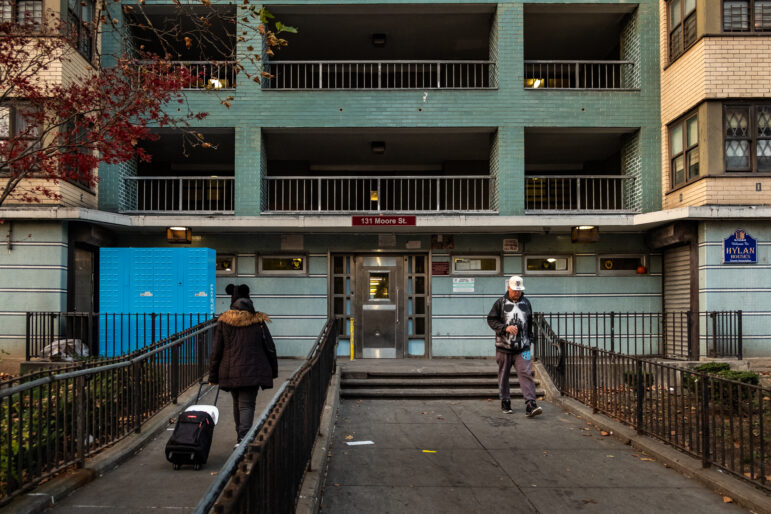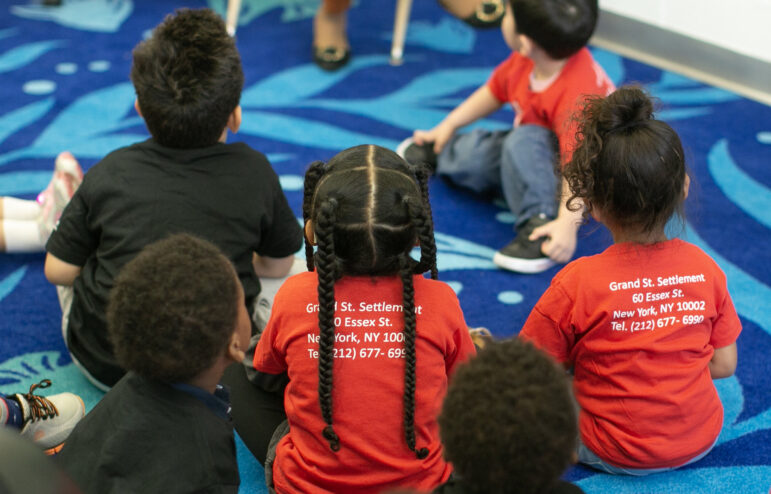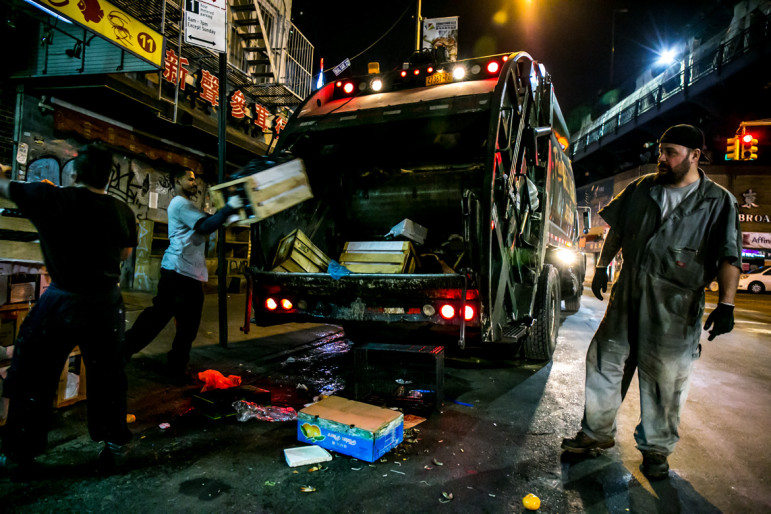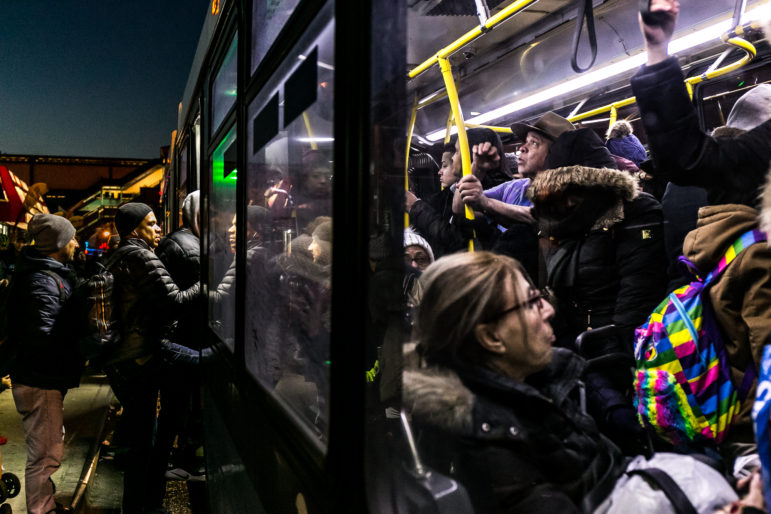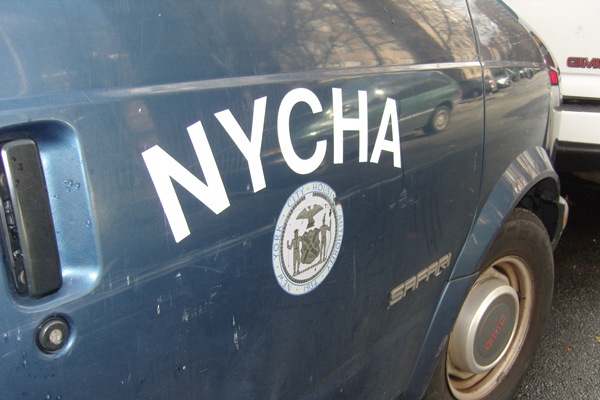
Photo by: Jarrett Murphy
At a public-housing complex in Brooklyn, a state judge’s ruling last month blocking the mayor’s big-soda ban doesn’t cause much upset. “Bloomberg is for people who got money,” says Gretchen Jordan, a 50-year-old resident of the New York City Housing Authority’s Carey Gardens development in Coney Island. “Your sugar intake is the least important issue. That’s between you and your doctor.”
Jordan has lived in Carey Gardens for over 20 years, and says that she’s looking for two things in the next mayor: someone who will create jobs, and someone who will do something about the difficulty of getting repairs done in NYCHA developments. “The backlog is just too big,” she says. “We need more repairmen, more contracts with plasterers and plumbers. We need more caretakers. Just because we’re low income, doesn’t mean it has to look like it.” As far as which candidate has got her vote, “That’s personal,” she says.
Though NYCHA is largely a federally funded agency executing federal policy, its organization and policies are in significant part shaped at the municipal level. Between public housing and rental vouchers, NYCHA serves a population one-third larger than that of Staten Island. Here are some questions the next mayor will face in governing this city within a city:
1. Who should lead NYCHA?
According to the state’s Public Officers law, NYCHA “shall consist of three members appointed by the mayor, one of whom shall be designated by the mayor as chairman removable at his pleasure.” In 2009, it was Mayor Bloomberg’s pleasure to appoint John Rhea to the position of Chairman of NYCHA, but Rhea has generated controversy in the role. He and his board were blamed for a backlog of over 400,000 repairs and $1 billion in unspent funds since 2009, both discussed in a series of Daily News articles over the summer. Then there was Rhea’s decision to bring in the Boston Consulting Group (BCG) to study the NYCHA on a pair of no-bid contracts totaling $10 million. Critics wondered why the recommendations that resulted from that report were kept secret for so long, and why Rhea failed to disclose in his official biography the fact that he used to work for BCG.
NYCHA dismissed some of the criticism as unfair, noting, for instance, that BCG has done similar work for other public-housing authorities, and pointing out that the agency had until this coming September to spend the “unspent” funds. Since receiving the results of the BCG report, Rhea and the Bloomberg administration have taken the consultants’ message to heart. NYCHA has introduced computer-based inventories and tried to get better control of its assets. Recently the mayor and chairman announced a plan to eliminate the maintenance backlog. Through an allocation of $10 million from the City Council, NYCHA has added 176 maintenance and repair workers since January, and will add 388 workers until the work-order gap is closed. As of March 11, 73,000 of 420,000 work orders have been completed, according to NYCHA’s website.
Despite those moves, several mayoral candidates (including Sal Albanese, Christine Quinn and Bill De Blasio) have said that if elected, they would replace NYCHA’s current chairman, John Rhea.
Who would they prefer for the job of NYCHA boss? At a recent public housing forum on housing, De Blasio said he “sure as hell wouldn’t choose someone from the private sector.” Quinn agreed that someone with experience in public housing would be imperative. In an interview, Albanese said his first objective with regards to NYCHA would be to find “a chairperson who is a visionary, with an understanding of housing.”
2. Do the agency’s management systems need a further overhaul than the current leadership has proposed?
NYCHA’s board has recently come under attack for their six-figure salaries of $187,147, replete with full-time drivers. Ironically, as Manhattan Borough Preside Scott Stringer pointed out in a 2012 report, the decision to pay board members for their service was originally implemented in 1958 as a solution to criticisms leveled at NYCHA that are eerily similar to those currently being lodged against the Authority. Nicholas Dagen Bloom writes in Public Housing That Worked that in response to “a sensationalistic series of articles in the Daily News documenting widespread mismanagement” detailing among other things, mismanagement and a backlog of complaints, Charles F. Preusse recommended that NYCHA’s board be changed from five volunteers to three salaried city employees.
Stringer’s report concluded that it’s time to return to “Mayor LaGuardia’s original vision for a primarily volunteer board with diverse professional backgrounds and points of view.” In February, Assemblyman Keith Wright filed legislation on behalf of Mayor Bloomberg to this effect. The new board is proposed to have two tenant members, instead of only one.
Further structural problems include allegations that the inefficient processing of Section 8 subsidy transfers resulted in unlawful evictions (The Legal Aid Society is suing NYCHA on this front). And advocacy groups like Community Voices Heard (CVH) have criticized the authority for not involving tenants more in the destiny of their housing projects, suggesting participatory budgeting as a way of empowering residents.
3. Should the city alter its financial relationship with NYCHA?
In 2006, the mayor provided a $100 million aid package that accompanied a hike in rents for the upper 27 percent of residents, a prime example of the give-and-take approach that critics say the administration has deployed toward public housing. Indeed, the aid package came on the heels of a Bloomberg decision in 2004 to eliminate an annual city subsidy of $19 million to NYCHA, as a result of which the ever-decreasing federal dollars must now cover maintenance to NYCHA’s city and state buildings as well.
The next mayor could restore the subsidy or eliminate some of the charges the city imposes on public housing. “With the stroke of a pen,” says Victor Bach, Senior Housing Policy Analyst at CSS, the mayor could assist NYCHA to the tune of $100 million a year. Until 1995, NYCHA had its own Police Department. When Mayor Giuliani merged NYCHA’s police with the NYPD, NYCHA struck a deal in which it would pay $75 million yearly for police services. Furthermore, while NYCHA doesn’t pay taxes, it pays the city what are known as Payment in Lieu of Taxes for services it utilizes, like sanitation.
These PILOTs cost NYCHA $23 million a year. According to Bach, the mayor should terminate all agreements made in which NYCHA pays the city, freeing up $100 million yearly. “The federal government gives to NYCHA, and the city takes from NYCHA,” Bach says. “The city of New York needs to stop taking money from its largest non-profit. This is clearly something the next mayor should do.”
Rhea says that this is not something the Authority is pursuing—at least under the current mayor. “No one has ever said to me, ‘What NYCHA needs is less police presence,'” he says. “Priorities have a cost. Both in terms of police services, as well the infrastructure that we are taxing as New York’s largest landlord, we pay much less than our fair share considering what we use.”
4. Should the city rezone major NYCHA projects to permit more infill and retail development?
NYCHA faces a severe funding shortfall. “One thing everyone agrees on,” Julia Vitullo-Martin, senior fellow at the Regional Plan Association and director of RPA’s Center for Urban Innovation, says, “is that the financial situation is dire.” Bach agrees: “The biggest challenge for NYCHA right now is adequately funding their operation.” Fiscal solvency must be maintained along with catching up on repairs. But with federal funding diminishing—”starvation funding,” Bach calls it—NYCHA must come up with creative solutions for solving its funding shortfalls.
NYCHA is already moving toward limited private, mainly market-rate developments on open space at a small number of developments, with the hope that lease payments on the new buildings will subsidize capital improvements to NYCHA’s existing stock.
Rhea has come under attack for this plan to lease some of NYCHA’s land (discussed at length here). While some, including mayoral hopeful William Thompson, have derided the plan as involving “luxury housing”, experts agree that the plan to generate funds for NYCHA’s capital upkeep might be one of the only measures NYCHA can take to generate funds from within. Furthermore, the plan may be well underway by the time the next mayor steps in.
Another potential solution to NYCHA’s funding shortfall, which could greatly benefit from mayoral support, would be rezoning some of the authority’s land, Vitullo-Martin says. NYCHA’s greatest asset is it property, which could serve as a source of revenue if tapped. Eliot Sclar, the Director of the Center for Sustainable Urban Development (CSUD) at Columbia University’s Earth Institute, agrees that NYCHA could greatly benefit from “retailers that meet the needs of the poor, rather than pricing them out,” but the current zoning of most of NYCHA’s property doesn’t allow for retail. The next mayor could be a friend or a foe to a rezoning process.
5. Should NYCHA return to its earlier policy of giving homeless people priority for public housing slots and Section 8 vouchers?
In 2004, the city stopped giving homeless people priority for openings in NYCHA and for Section 8 vouchers, based on the idea that providing those benefits would incentivize people to seek out shelter living, ultimately costing the city more money.
To replace those exit strategies, the Bloomberg Administration put in place a consecutive series of temporary programs for people leaving the shelter, the last of which—Advantage—collapsed after a state budget cut. The absence of any post-shelter housing program is largely blamed for the city’s rising shelter census. The next mayor will have to decide whether reinstating priority for the homeless in the city’s existing low-income housing infrastructure might be a solution.
In June, the Independent Budget Office released a report, commissioned by the Coalition for the Homeless, that investigates the fiscal impact of returning to the old policy under which the homeless had priority for Section 8 and NYCHA. They were trying to ascertain the truth of Bloomberg’s claim that the priority program would result in more families entering and staying in shelter with the hopes of getting more permanent housing. Through a statistical analysis, they found that if 5,000 families were placed in NYCHA and Section 8 housing, the amount of families entering shelter would increase slightly—by 9 percent—and the amount leaving would decrease slightly—by 18 percent, but the net effect would save the city $11 million a year. Even if priority was only available for NYCHA (the federal government is scaling back on Section 8), the city would still end up saving about $5.5 million, according to IBO.
Candidates Albanese and Christine Quinn both stated in CSS’s survey of “The Unheard Third” that if elected, they plan to renew the priority program. But this decision is not a simple one. While homeless advocates would surely support such a move, NYCHA residents might have more complex feelings about it.
6. Is a new public safety strategy needed for public housing?
Safety is another big concern of residents. In 2009, NYCHA partnered with public housing’s Citywide Council of Presidents (CCOP) and the NYPD to create a “Safety and Security Task Force,” the reports of which were released in 2011. The Task Force came up with four goals: improve public housing’s physical security infrastructure, deter crime, discourage and redress “evidence of disorder” such as broken doors and other vandalism that can lead to more serious crime, and assist residents in complying with all NYCHA guidelines. Originally intended as a temporary initiative, the next mayor might want to make this a fixture in dealing with NYCHA’s security and residents’ quality of life.
But aggressive policing is also a hotly debated issue in public housing. Recently, the Bronx District Attorney announced that people stopped for alleged trespassing public housing buildings would no longer be prosecuted unless the arresting officer is interviewed, a measure that no other DA has taken and which is aimed at quelling complaints against the controversial measure. Giuliani’s merger of NYCHA’s police force with the NYPD robbed housing developments of their relationships with cops who knew the population they are serving. Although new guidelines for police were released with Task Force’s report, the next mayor might want to rethink Giuliani’s decision to dismantle NYCHA’s own police force.


